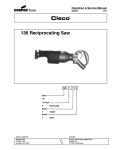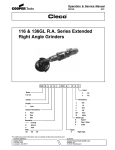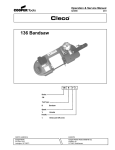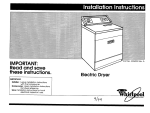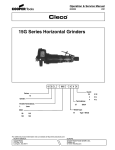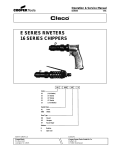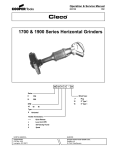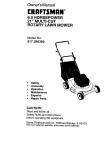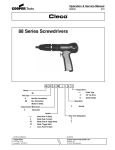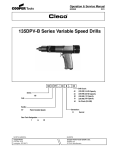Download Cooper Tools Cleco 136 Service manual
Transcript
Operation & Service Manual 823066 2/01 116 & 136 Series Die Grinders XXX G L X X - XXX - C X - X Series: Kit: 116, 136 Terminations: Grinder: 3 6M 6 4 5 Throttle: L Lever Exhaust Terminations: F R S Front Rear Side Wheel Type: C Generation: Concept B Second RPM: 180 200 3/16 6mm 3/8 1/4 5/16 Collet 240 250 NORTH AMERICA EUROPE CooperTools P.O. Box 1410 Lexington, SC 29071 Cooper Power Tools GmbH & Co. Postfach 30 D-73461 Westhausen 1 Safety Recommendations For your safety and the safety of others, read and understand the safety recommendations before operating any grinder. loads and stresses on the tool parts and may result in breakage. Installation of a filter-regulator-lubricator in the air supply line is highly recommended. Always wear protective equipment and clothing. Personal hearing protection is recommended when operating or working near this tool. 2 CAUTION 0 WARNING ! OVER Repetitive work motions and/or vibration can cause injury to hands and arms. Use minimum hand grip force consistent with proper control and safe operation. Keep body and hands warm and dry. Avoid anything that inhibits blood circulation. Avoid continuous vibration exposure. Keep wrists straight. Avoid repeated bending of wrists and hands. Hearing protection is recommended in high noise areas (above 85 dBA). Close proximity of other tools, reflective surfaces, process noises, and resonant structures can substantially contribute to the sound level experienced by the user. CAUTION Do not remove this tag until the operator of this tool has read these safety precautions. 202101 WARNING TAG Personal hearing protection is recommended when operating or working near this tool. 6 Cleco grinders are designed to operate on 90 psig (6.2 bar) max. air pressure. If the tool is properly sized and applied, higher air pressure is unnecessary. Excessive air pressure increases the 5 Grinding or other use of this tool may produce hazardous fumes and/or dust. To avoid adverse health effects utilize adequate ventilation and/or a respirator. Respirators should be selected, fitted, used and maintained in accordance with Occupational Safety and Health Administration and other applicable regulations. Read the material safety data sheet on any materials involved in the grinding process. CAUTION Wear respirator where necessary. MODEL SERIAL NO. WARNING Cleco ! 3 • Do not wear loose fitting clothing, or clothing that may restrict movement, become entangled or in any way interfere with the safe operation of the grinder. 2 • Gloves and other protective clothing should be worn as required, unless they create a greater hazard. 1 Hearing protection is recommended in high noise areas (above 85 dBA). Close proximity of additional tools, reflective surfaces, process noises, and resonant structures can substantially contribute to the sound level experienced by the operator. Proper hearing conservation measures, including annual audiograms and training in the use and fit of hearing protection devices may be necessary. For additional information on hearing protection, refer to Federal OSHA Regulations, 29 CFR, Section 1910.95, Occupational Noise Exposure, and American National Standards Institute, ANSI S12.6, Hearing Protectors. TACHOMETER WARNING CAUTION ! ! The speed rating and warning information on the tool should be maintained or replaced for legibility in the event of damage. Before installing any accessory (mounted wheels, carbide burrs, etc.), after all tool repairs, and whenever a grinder is issued for use, check the free speed of the tool with a tachometer to make sure actual free speed at 90 psig does not exceed rated free speed stamped on tool. Grinders in use on the job must be checked at least once every 20 hours of operation, or once a week, whichever is most frequent. ! Caution: Faceshields do not provide unlimited protection against flying particles and are not to be considered as eye protection. ANSI Z87.1 states that separate eyewear shall be used. For additional information on eye protection, refer to Federal OSHA Regulations, 29 CFR, Section 1910.133, Eye and Face Protection, and ANSI Z87.1, Occupational and Educational Eye and Face Protection. This standard is available from the American National Standards Institute, Inc., 11 West 42nd street, New York, NY 10036. Impact resistant eye protection must be worn while operating or working near this tool. Impact resistant eye protection must be worn while operating or working near this tool. Read Operating Instructions carefully. Follow the Safety Recommendations for your safety and the safety of others. WARNING 4 ! Before the tool is connected to air supply, check throttle for proper operation, i.e., throttle moves freely and returns to closed position. Being careful not to endanger adjacent personnel, clear air hose of accumulated dust and moisture. Use protective barriers where necessary — hot sparks can burn. Barriers also help reduce noise levels. Before removing tool from service or changing accessories, make sure air line is shut off and drained of air. This will prevent tool from operating if throttle is accidently engaged. Do not use tool to drain residual air from air line, instead use of a self-relieving valve located near tool is highly recommended. INSPECT THE MOUNTED WHEEL OR CARBIDE BURR Fragments from a mounted wheel or carbide burr that breaks or comes apart ! while rotating can cause serious injury or even death. Inspect mounted wheel or accessory. Check the maximum safe RPM marked on the accessory or package. Never use an accessory rated at or below actual tool speed. Cracked, dropped, faulty, or bent accessories are dangerous. Suspect accessories should not be used and should be disposed of. Look for cracks, chips, water stains, or signs of abuse or improper storage. Causes of accessory failures have been traced to such factors as: WARNING • Dropping, bumping, or abuse (careless handling of the grinder) • Improper mounting • Imbalance • Improper shipment or storage, or age • Mismatched speed ratings • Exposure to water, solvents, high humidity, freezing, and extreme temperatures Accessories known to have been subjected to any of the conditions above can burst violently and should be destroyed rather than risk their use by someone who may not notice that they are damaged. Safety Recommendations ACCESSORY MOUNTING The collet should be checked to assure it is in good operating condition and is secure to the tool. Accessories should be inserted to full depth of the collet. Avoid excessive overhang that can result in vibration, or a bent spindle if excessive down force is used. Possible loss or ejection of accessory can result. Collet equipped 116/136 grinders are intended for use with small carbide burrs ! and mounted wheels only. Do not use these tools for Type 1 wheel grinding. If your application calls for a Type 1 wheel, consult your Cleco representative for a wheel grinder equipped with the proper wheel guard. WARNING BEGINNING GRINDING OPERATION Before using or after mounting an accessory, tool must be run for one minute in a protected enclosure to check the integrity of the accessory. During this time or any other time, no one should stand in front or in line of the accessory. When starting work with a cold wheel, apply it gradually to the workpiece until it becomes warm. Do not continue to use a grinder if: • The speed rating of the accessory is less than the speed of the grinder • It starts to vibrate • You sense changes in tool speed or an unusual increase in noise that would indicate tool is running at excessive speed • You notice excessive end play in spindle • You hear any unusual sound from grinder RETURN THE TOOL TO THE TOOL CRIB FOR SERVICE IMMEDIATELY! Some individuals may be susceptible to disorders Repetitive work motions and/or vibration of the hands and arms may cause injury to hands and arms. when performing tasks Use minimum hand grip force consistent with proper control and safe operation. consisting of highly repetiKeep body and hands warm and dry. tive motions and/or expoAvoid anything that inhibits blood circulation. Avoid continuous vibration exposure. sure to extended vibraKeep wrists straight. tion. Cumulative trauma Avoid repeated bending of wrists and hands. disorders such as carpal tunnel syndrome and tendonitis may be caused or aggravated by repetitious, forceful exertions of the hands and arms. Vibration may contribute to a condition called Raynaud's Syndrome. These disorders develop gradually over periods of weeks, months, and years. It is presently unknown to what extent exposure to vibrations or repetitive motions may contribute to the disorders. Hereditary factors, vasculatory or circulatory problems, exposure to cold and dampness, diet, smoking and work practices are thought to contribute to the conditions. ! the shoulders, arms, wrists, or fingers is advised to consult a physician. If it is determined that the symptoms are job related or aggravated by movements and postures dictated by the job design, it may be necessary for the employer to take steps to prevent further occurrences. These steps might include, but are not limited to, repositioning the workpiece or redesigning the workstation, reassigning workers to other jobs, rotating jobs, changing work pace, and/or changing the type of tool used so as to minimize stress on the operator. Some tasks may require more than one type of tool to obtain the optimum operator/tool/task relationship. The proper selection of the correct type of grinder is an important ergonomic consideration. Each application should be carefully considered and the tool chosen that will minimize the stresses on the operator that can lead to the onset of cumulative trauma disorders. Some tasks require more than one type of tool to obtain the optimum operator/tool/task relationship. Cleco has a complete selection of tools including vertical, straight, angle, and extended grinders that make possible the correct ergonomic match of the operator, tool, and task. The following suggestions will help reduce or moderate the effects of repetitive work motions and/or extended vibration exposure: • Use a minimum hand grip force consistent with proper control and safe operation • Keep body and hands warm and dry (cold weather is reported to be a major factor contributing to Raynaud's Syndrome) • Avoid anything that inhibits blood circulation —Smoking Tobacco (another contributing factor) —Cold Temperatures —Certain Drugs Avoid OK Avoid Avoid OK Avoid Neutral Ulnar Deviation WARNING Any tool operators should be aware of the following warning signs and symptoms so that a problem can be addressed before it becomes a debilitating injury. Any user suffering prolonged symptoms of tingling, numbness, blanching of fingers, clumsiness or weakened grip, nocturnal pain in the hand, or any other disorder of Extension Neutral Flexion Radial Deviation • Tasks should be performed in such a manner that the wrists are maintained in a neutral position, which is not flexed, hyperextended, or turned side to side • Stressful postures should be avoided — select a tool appropriate for the job and work location • Avoid highly repetitive movements of hands and wrists, and continuous vibration exposure (after each period of operation, exercise to increase blood circulation) • Use quality accessories (the primary source of vibration when using a grinder is an accessory that is out of balance, out of round, untrue, or possibly any combination of all three; avoid excessive overhang of accessory in collet) • Use carbide burrs that are sharp, as dull burrs require more force and effort to remove material • Keep tool well maintained and replace worn parts (a preventive maintanance program with scheduled inspections is highly recommended) 3 Safety Recommendations Work gloves with vibration reducing liners and wrist supports are available from some manufacturers of industrial work gloves. Tool wraps and grips are also available from a number of different manufacturers. These gloves, wraps, and wrist supports are designed to reduce and moderate the effects of extended vibration exposure and repetitive wrist trauma. Since they vary widely in design, material, thickness, vibration reduction, and wrist support qualities, it is recommended that the glove, tool wrap, or wrist support manufacturer be consulted for items designed for your specific application. WARNING! Proper fit of gloves is important. Improperly fitted gloves may restrict blood flow to the fingers and can substantially reduce grip strength. USE QUALITY ACCESSORIES The primary source of vibration when using a die grinder is an accessory that is out of balance, out of round, untrue, or possibly any combination of all three. The use of accessories which are well balanced, round, and true is highly recommended as they have been found to significantly reduce vibration. Some accessories lose their balance, roundness, and trueness as they wear from use. Because of the abusive nature of the vibration caused by out of balance, out of round, and untrue condition of some mounted wheels and carbide burrs, it is felt that these accessories are more suseptible to failure. Excessive vibration may signal eminent wheel failure. Out of balance accessories are dangerous. Flat spotting of a mounted wheel, caused by grinding the wheel to a stop after the power has been shut off can result in changes to the balance and shape of the wheel. Be sure the mounted wheel has stopped before setting the tool down. Set the tool in a tool rest or tool holder when not in use. WIRE BRUSHES If a die grinder is used for wire brushing applications the same problems of balance, roundness, and trueness as experienced with mounted wheels and other accessories prevail. Use quality wire brushes. USE A PREVENTIVE MAINTENANCE PROGRAM Tool abuse or poor maintenance procedures can amplify and contribute to the vibration produced by a mounted wheel or carbide burr. A preventive maintenance program featuring scheduled periodic inspections and proper maintenance is the best way to assure safety in your portable grinding operations. A well managed program can, for example, detect such things as speed variations due to wear, flanges or spindles that have been damaged from abuse, or bad bearings damaged by foreign matter or lack of lubrication. Problems such as these can affect the wheel trueness when the grinder is running and contribute to the vibration. Rotor blades that are worn or chipped can lock up the motor and damage motor components. Rotor blades should be checked periodically and replaced if they measure less than 3/16" (4.7mm) at either end. Proper repair procedures and the use of original Cleco service parts and bearings rather than substitutes will return the tool to factory specifications of precision and balance, and minimize vibration. Replace if 3/16" (4.7mm) or less at either end. 4 PROPER LUBRICATION An automatic in-line filter-regulator-lubricator is recommended as it increases tool life and keeps the tool in sustained operation. The in-line lubricator should be regularly checked and filled with a good grade of 10W machine oil. Proper adjustment of in-line lubricator is performed by placing a sheet of paper next to exhaust ports and holding throttle open approximately 30 seconds. Lubricator is properly set when a light stain of oil collects on paper. Excessive amounts of oil should be avoided. STORAGE In the event it becomes necessary to store tool for an extended period of time (overnight, weekend, etc.), it should receive a generous amount of lubrication at that time and run for several seconds to distribute oil before disconnecting from air supply. This will reduce corrosion and displace water that may be trapped in tool. This information is a compilation of general safety practices obtained from various sources available at the date of production. However, our company does not represent that every acceptable safety practice is offered herein, or that abnormal or unusual circumstances may not warrant or require additional procedures. Your work may require additional specific safety procedures. Follow these procedures as required by your company. For more information, see the latest edition of ANSI B186.1, Safety Code for Portable Air Tools, and ANSI B7.1, Safety Requirements for the Use, Care, and Protection of Abrasive Wheels, available from the American National Standards Institute, Inc., 11 West 42nd street, New York, NY 10036. OPERATING INSTRUCTIONS READ SAFETY RECOMMENDATIONS BEFORE CONNECTING TOOL. The 116 and 136 Series Die Grinders are designed to operate on 90 psig (6.2 bar) maximum air pressure, using a 1/4" hose up to 8' in length for the 116 and a 5/16" hose for the 136. If additional length is required, the next larger hose size may be connected to the 8' whip hose. LUBRICATION An automatic in-line filter-lubricator is recommended as it increases tool life and keeps the tool in sustained operation. The in-line lubricator should be regularly checked and filled with a good grade of 10W machine oil. Proper adjustment of the in-line lubricator is performed by placing a sheet of paper next to the exhaust ports and holding the throttle open approximately 30 seconds. The lubricator is properly set when a light stain of oil collects on the paper. Excessive amounts of oil should be avoided. STORAGE In the event that it becomes necessary to store the tool for an extended period of time (overnight, weekend, etc.), it should receive a generous amount of lubrication at that time and again when returned to service. The tool should be stored in a clean and dry environment. SERVICE INSTRUCTIONS REASSEMBLY The tool is reassembled in the reverse order of disassembly. Wash all parts in a solvent and inspect for damage or wear. It is recommended that new rotor blades be installed at each repair cycle. If not replaced, the used ones must measure a minimum of 3/16" (4.7mm) at both ends. Replace if 3/16" (4.7mm) or less at either end. Replace bearings that are rough or have excessive end play. Install the front rotor bearing in the front bearing plate and measure the distance from the face of the bearing plate to the inner race of the bearing with the bearing race loaded rearward. Select or fit by sanding a rotor collar .001" (.025mm) to .002" (.050mm) longer than this measurement. Install the rotor blades, cylinder rear bearing plate and rear bearing on the rotor. After final assembly of the motor unit, the cylinder should be held securely but not tightly between the two plates. The rotor should not rub either plate. When installing a motor into a rear exhaust backhead, the steel ball located in the front plate must line up with the groove in the backhead. Tighten all joints securely during reassembly. Place a few drops of 10W machine oil in the air inlet to ensure positive lubrication of all motor parts as soon as air is applied. CAUTION: After the grinder is reassembled, be sure to check the free speed (R.P.M.) for proper speed with a dependable tachometer before returning the grinder to service. DISASSEMBLY Unscrew (left hand threads) the bearing retainer and slip the motor unit out of the backhead. To remove the collet chuck, insert a 3/16" Allen wrench into the chuck to engage the rotor. Hold the Allen wrench in a vise and unscrew the collet chuck. Use a suitable driver to drive the front rotor shaft out of the front rotor bearing. After removing the cylinder and rotor blades, the rear rotor shaft may be driven out of the rear rotor bearing. The throttle valve may be removed by unscrewing the inlet bushing. The inlet air screen should be washed in a solvent and blown out in reverse of normal air flow. Replace the screen if damaged or torn. 5 116 & 136 DIE GRINDER MOTOR UNITS OPTIONAL ROTOR COLLAR 116 ROUTER ATTACHMENT 864018 864020 613701 619016 864017 Rotor Model Part No. 116 869780 136 869781 863873 847528 847234 869614 Rotor Blade Model Part No. 116 867816 136 869449 812165 864487 864488 864489 864490 847525 864492 864493 865416 865417 202076 202187 202188 .120 .121 .122 .123 .124 .125 .126 .127 .128 .129 .130 .131 812165 869445 OF Cylinder Model Part No. 116 869450 136 869451 F Front Bearing Plate Type Exhaust Part No. Front/Side 869448 Rear 202286 849844 SIZE (Rear Exhaust Only) 847525 849837 PART NO. 847803 Collet Size Part No. 3/16" 865423 6mm 864158 1/4" 847811 5/16" 865501 3/8" 847805 863888 Rear Bearing Plate Type Exhaust Part No. Front/Side 869638 Rear 202285 202230 (Side Exhaust Only) Exhaust Deflector Type Exhaust Part No. Front 202228 Side 202229 Muffler Type Type of Tool Exhaust 116 136 Front 202338 869452 Side 869452 869452 PARTS LIST — MOTOR UNITS Part No. Name of Part 202228 202229 202230 202285 202286 202338 613701 619016 812165 847234 847525 847528 847803 847805 847811 849837 849844 863873 Front Exhaust Detlector Side Exhaust Deflector "O"-Ring 1- 1/2" x 1- 5/8" Rear Bearing Plate Front Bearing Plate Muffler Ball Bearing Retainer Ring Cylinder Pin "O"-Ring 1-1/8" x 1-1/4" Rotor Collar .124" Front Rotor Bearing Chuck Lock Nut 3/8" Collet (Opt.) 1/4" Collet (Std.) 9/16" x 11/16" Wrench (136G Requires One (1) Only) 5/8" x 3/4" Wrench Front Bearing Retainer Qty. Part No. 1 1 1 1 1 1 1 1 2 1 1 1 1 1 1 2 1 1 The router attachment can be purchased as a subassembly using Part No. 861804. 6 863888 864017 864018 864020 864158 865423 865501 867816 869445 869448 869449 869450 869451 869452 869614 869638 869780 869781 Name of Part Chuck Shank (Includes 847803) Lock Nut Router Foot Sleeve 6mm Collet (Opt.) 3/16" Collet (Opt ) 5/16" Collet (Opt.) Rotor Blade Rear Rotor Bearing Front Bearing Plate Rotor Blade Cylinder (Includes Rear Cyl. Pin) Cylinder (Includes Rear Cyl. Pin) Muffler Router Body Rear Bearing Plate Rotor Rotor Qty. 1 1 1 1 1 1 1 4 1 1 4 1 1 1 1 1 1 1 116 & 136 DIE GRINDER HANDLES ALL MODELS 202106 202105 Front/Side Exhaust Backhead Model No. Part No. 116G-250 202107 136G-180 202109 136G-240 202110 869855 845409 847808 202104 869712 202103 203043 846664 869489 FRONT/SIDE EXHAUST MODELS Tool RPM 15,000 18,000 20,000 25,000 REAR EXHAUST MODEL 847767 847272 Part No. 202289 869845 863880 869850 202288 844309 869844 202287 863454 833188 833300 Rear Exhaust Backhead Type Grinder RPM Part No. Collet 15,000 202711 Collet 18,000 202222 Collet 20,000 202215 Collet 25,000 202221 PARTS LIST — HANDLES Part No. 202103 202104 202105 202106 202107 202109 202110 202215 202221 202222 202287 202288 202289 202711 203043 Name of Part Inlet Bushing Throttle Valve Pin (incl. 869712) Toggle Lock-Off Lever Backhead (incl. 846664) Backhead (incl. 846664) Backhead (incl. 846664) Backhead (incl. 846664) Backhead (incl. 846664) Backhead (incl. 846664) Inlet Bushing (incl. 833300) Throttle Valve Throttle Valve Seat Backhead (incl. 846664) Inlet Screen Qty. Part No. Name of Part 1 1 1 1 1 1 1 1 1 1 1 1 1 1 1 833188 833300 844309 845409 846664 847272 847767 847808 863454 863880 869489 869712 869844 869845 869850 869855 Throttle Valve Spring Inlet Screen "O"-Ring 7/16"x 5/8" Toggle Pin Throttle Pin Bushing "O"-Ring 5/8"x 3/4" Throttle Valve Spring Throttle Lever Pin "O"-Ring 9/16"x 11/16" "O"-Ring 1-1/4 x 1-3/8 Throttle Valve "O"-Ring 5/64"x 13/64" Exhaust Deflector Throttle Valve Seat Muffler Felt Toggle Spring COMPLETE HANDLE SUBASSEMBLIES Model No. 116GL-250 136GL-180 136GL-240 136GLR-150 136GLR-180 136GLR-200 136GLR-250 Type Tool Collet Collet Collet Collet Collet Collet Collet RPM 25,000 18,000 24,000 15,000 18,000 20,000 25,000 Part No. 861991 861994 861995 201178 861132 861137 861131 Qty. 1 1 1 1 1 1 1 1 1 1 1 1 1 1 2 1 The lock-off lever can be purchased as a subassembly using Part No. 861992. 7 CooperTools 670 Industrial Drive Lexington, SC 29072 Phone: (803) 359-1200 Fax: (803) 359-2013 www.cooperindustries.com 8









